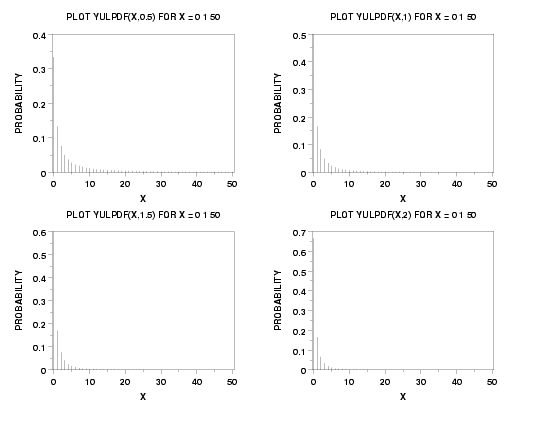YULPDF
Name:
Type:
Purpose:
Compute the Yule probability mass function.
Description:
The Yule distribution has the following probability mass
function:
with p denoting the shape parameter and
 denoting the gamma function (HELP GAMMA for details).
denoting the gamma function (HELP GAMMA for details).
Dataplot computes the Yule probability density function
using the log gamma function. The Yule distribution has
increasingly long tails as p goes to zero. Currently,
Dataplot limits the Yule pdf function to the case where
p >= 0.1.
Syntax:
LET <y> = YULPDF(<x>,<p>)
<SUBSET/EXCEPT/FOR qualification>
where <x> is a non-negative integer number, parameter, or
variable;
<p> is a positive number, parameter, or variable
that specifies the shape parameter;
<y> is a variable or a parameter (depending on
what <x> is) where the computed Yule pdf value
is stored;
and where the <SUBSET/EXCEPT/FOR qualification> is optional.
Examples:
LET A = YULPDF(3,1.5)
LET A = YULPDF(X,P)
PLOT YULPDF(X,2) FOR X = 0 1 50
Note:
The Yule is a special case of the Waring distribution.
Specifically,
YULPDF(X,P) = WARPDF(X,P-1,1)
Note:
The following commands for generating random numbers,
probability plots, and goodness of fit statistics for the
Yule distribution are available:
LET P = <value>
LET Y = YULE RANDOM NUMBERS FOR I = 1 1 N
YULE PROBABILITY PLOT Y
YULE CHI-SQUARE GOODNESS OF FIT Y
The following graphical methods for estimating the shape
parameter are available:
YULE PPCC PLOT Y
YULE KS PLOT Y
Our experience indicates that the KS PLOT is more effective
than the PPCC PLOT for estimating the shape parameter.
The follwing command
YULE MAXIMUM LIKELIHOOD Y
can be used to generate the following estimates of the
shape parameter:
- The method of moments:
with  denoting the sample mean. Note that this method will
never generate an estimate less than 1 (the mean is
undefined for p < 1 for the Yule distribution).
denoting the sample mean. Note that this method will
never generate an estimate less than 1 (the mean is
undefined for p < 1 for the Yule distribution).
- The method of zero frequency and sample mean:
with N and f1 denoting the sample size
and the observed first frequency.
This method is only useful for values of the shape
parameter > 1.
- The method of maximum likelihood:
The maximum likelihood estimate is the solution
of the following equation:
with N denoting the sample size,
Vk the cumulative frequency from
k upwards, and
 the maximum frequency.
the maximum frequency.
Then the parameter, p, of the Yule distribution
is
These estimation methods are discussed in detail in
the Irwin article (see the Reference section belows).
Default:
Synonyms:
Related Commands:
|
YULCDF
|
= Compute the Yule cumulative distribution function.
|
|
YULPPF
|
= Compute the Yule percent point function.
|
|
WARPDF
|
= Compute the Waring probability density function.
|
|
BBNPDF
|
= Compute the beta-binomial probability density
function.
|
|
GEOPDF
|
= Compute the geometric probability density function.
|
|
NBPDF
|
= Compute the negative binomial probability density
function.
|
|
HYPPDF
|
= Compute the hypergeometric probability density
function.
|
Reference:
"Discrete Univariate Distributions", Second Edition, Johnson,
Kotz, and Kemp, John Wiley & Sons, 1994 (pp. 274-279).
"Mathematcs in Medical and Biological Statistics", J. O. Irwin,
Journal of the Royal Statistical Society, A, 1963, pp. 1-44.
Applications:
Implementation Date:
Program:
Y1LABEL Probability
X1LABEL X
LABEL CASE ASIS
X1LABEL DISPLACEMENT 12
Y1LABEL DISPLACEMENT 12
MULTIPLOT 2 2
MULTIPLOT CORNER COORDINATES 0 0 100 100
XTIC OFFSET 0.5 0.5
LINE BLANK
SPIKE ON
TITLE AUTOMATIC
X1LABEL X
Y1LABEL PROBABILITY
TITLE SIZE 3
PLOT YULPDF(X,0.5) FOR X = 0 1 50
PLOT YULPDF(X,1) FOR X = 0 1 50
PLOT YULPDF(X,1.5) FOR X = 0 1 50
PLOT YULPDF(X,2) FOR X = 0 1 50
END OF MULTIPLOT

Date created: 7/7/2004
Last updated: 7/7/2004
Please email comments on this WWW page to
[email protected].
|



